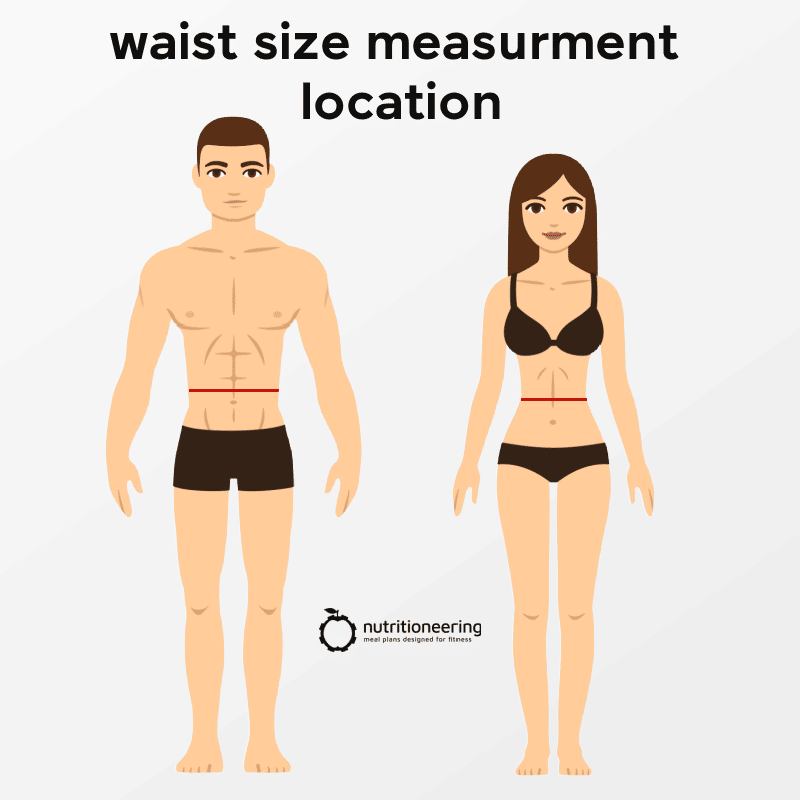How Big Is a 32 Inch Waist?
By: Jeremy Fox, CNC, CPT – Published: August 1, 2023
Waist circumference is a measurement that is used universally to determine clothing size, fitness level, and overall health. However, you may be unsure what a good waist size is for you.
If your waist measures 32 inches, you may be curious about whether it is considered big, small, or average. This article aims to address all your queries related to waist measurement.

What is a 32 Inch Waist?
Your waist measurement is the circumference around your abdomen, and it can be used for various purposes, such as buying clothes and assessing health risks like diabetes and heart disease.
However, it is essential to measure your waist accurately to confirm that it is indeed 32 inches around.
How to Measure Your Waist
To measure your waist size, you’ll need a flexible tape measure. Begin by wrapping it around your waist, parallel to the floor, and just above your hip bone. Pull the tape snugly but not so tight that it indents into your skin.
Remember to take the reading at the end of a normal exhale without sucking in your stomach. The number where the end of the tape intersects is your waist size.

Is a 32 Inch Waist Big?
In general, a waist size of 32 inches is somewhat average. However, whether it is considered big or small depends on your gender and who you are comparing yourself to.
Let’s look at some statistics on waist sizes for men and women.
32 Inch Waist for Women
Did you know that the average waist size for women in the US is 35.6 inches? Therefore, a 32-inch waist is slightly smaller than the norm for females.
However, it’s important to note that three out of four adult women in the US are overweight or obese. Hence, it might not be a fair comparison to measure oneself against the general population.
A survey conducted on women serving in the US Army, who are generally more physically fit, indicates that their average waist size is 28.2 inches. This means a 32-inch waist would be larger than 90% of athletic women.
Table 1. 32 Inch Waist for Women
| Normal | Fitness | |
|---|---|---|
| 1st | 25.4 | 23.9 |
| 5th | 27.8 | 25.1 |
| 10th | 28.9 | 25.7 |
| 15th | 30.0 | 26.1 |
| 20th | 30.7 | 26.5 |
| 25th | 31.6 | 26.8 |
| 40th | 33.9 | 27.7 |
| 50th | 35.6 | 28.2 |
| 60th | 37.2 | 28.9 |
| 75th | 40.3 | 30.0 |
| 80th | 41.5 | 30.5 |
| 85th | 42.8 | 31.1 |
| 90th | 44.7 | 31.9 |
| 95th | 47.6 | 33.2 |
| 99th | 53.8 | 35.8 |
32 Inch Waist for Men
By comparison, the average waist size for an American man is 38.2 inches. And a 32-inch waist would be smaller than about 90% of average men.
Again, this data comes from the general population of adults, which is largely overweight. So it’s better to compare yourself to fit men, like those in the military.
The average waist size bumps down to 32.8 inches from a sample of active males. So a 32-inch waist is actually pretty normal among fit men.
Table 2. 32 Inch Waist for Men
| Normal | Fitness | |
|---|---|---|
| 1st | 27.8 | 27.5 |
| 5th | 30.0 | 28.7 |
| 10th | 31.6 | 29.5 |
| 15th | 32.8 | 30.0 |
| 20th | 33.9 | 30.5 |
| 25th | 34.8 | 31.0 |
| 40th | 36.9 | 32.1 |
| 50th | 38.2 | 32.8 |
| 60th | 39.6 | 33.6 |
| 75th | 42.2 | 35.0 |
| 80th | 43.4 | 35.5 |
| 85th | 44.8 | 36.2 |
| 90th | 46.4 | 37.0 |
| 95th | 49.5 | 38.2 |
| 99th | 56.2 | 40.5 |
32 Inch Waist FAQ
Now you know how big a 32-inch waist is for men and women. But you might have more questions about this topic. So here are some quick answers to common queries.
What size is a 32 inch waist?
A 32-inch waist typically corresponds to a US dress size of 12-14. This waist circumference should also put you in a size Medium or Large for other women’s clothing.
At the same time, men with a 32-inch waist would likely fit into a size Medium for clothing.
What pants size is a 32 inch waist?
A waist size of 32 inches generally corresponds to a pant size of 31 for women and 31-32 for men. So your jeans size doesn’t always reflect your actual waist size.
One reason for this is how you wear your pants. For example, women’s pants tend to sit higher on the waist, close to the measurement site. In contrast, men wear their pants lower on their hips, where their waists might be smaller.
In addition, your actual waist size may not reflect your pant size due to your body proportions. For instance, you may need to size up if you have thicker thighs or a bigger butt.

Is a 32 inch waist good for a woman?
For women, a 32-inch waist is slightly smaller than usual. But the average American woman is overweight, so this waist size probably isn’t a good target if you’re trying to improve your overall health and wellness.
Still, a waist this size could be a reasonable short-term goal if your waist is currently larger. So whether 32 inches is a suitable waist size is relative to where you are now.
In addition, your ideal waist size depends on your body type and height. For instance, a 32-inch waist is worse for a shorter woman than a taller one.
Is a 32 inch waist good for a man?
This waist size is about 6 inches smaller than the typical American man’s. So a 32-inch waist would be a decent target for the average male.
Again, whether a 32-inch waist size is right for you depends on your body type and overall size.
Waist Size and Body Type
Your waist circumference can be affected by your body type. For example, the ectomorph body type has straighter lines and a naturally smaller waist. By comparison, the endomorph body type has more curves and a thicker waist.
As a result, it’s vital to use specific diet and workout strategies to reduce your waist size based on your body type.
Next Step: Take My Free Body Type Quiz
More Body Measurements
In addition to waist size, you can learn a lot about your health and fitness from other body measurements. So here are some additional articles that I think you’ll find interesting.
20-Inch Thighs for Men & Women
Average Neck Size & Why It Matters
Average Bicep Size By Height & Gender
If you liked this article, check out some of my other awesome content below. You’ll find helpful tips on nutrition, supplements, and workouts to reach your fitness goals faster.
References
1) Dobbelsteyn, C. J., et al. “A comparative evaluation of waist circumference, waist-to-hip ratio and body mass index as indicators of cardiovascular risk factors. The Canadian Heart Health Surveys.” International journal of obesity 25.5 (2001): 652-661.
2) Feller, Silke, Heiner Boeing, and Tobias Pischon. “Body mass index, waist circumference, and the risk of type 2 diabetes mellitus: implications for routine clinical practice.” Deutsches Ärzteblatt international 107.26 (2010): 470.
3) World Health Organization. “Waist circumference and waist-hip ratio: report of a WHO expert consultation, Geneva, 8-11 December 2008.” (2011).
4) Ford, Earl S., Ali H. Mokdad, and Wayne H. Giles. “Trends in waist circumference among US adults.” Obesity research 11.10 (2003): 1223-1231.
7) National Health Statistics Reports, & Stierman, B., National Health and Nutrition Examination Survey 2017–March 2020 Prepandemic Data Files—Development of Files and Prevalence Estimates for Selected Health Outcomes (n.d.).
6) United States, Congress, Research, Development, and Engineering Center, et al. 1988 ANTHROPOMETRIC SURVEY OF U.S. ARMY PERSONNEL: METHODS AND SUMMARY STATISTICS, 1988, pp. 298-299.











